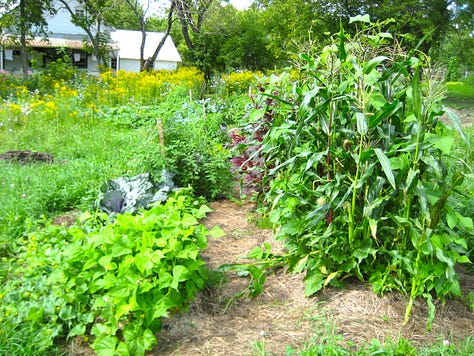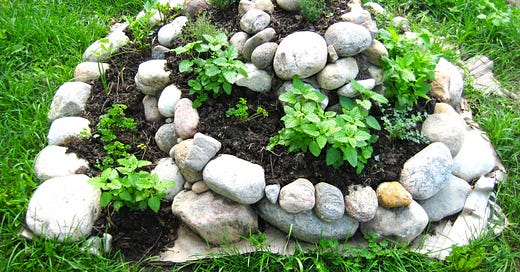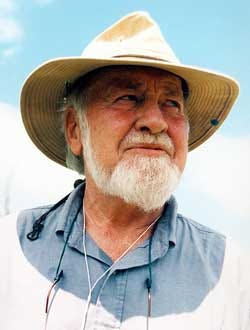I remember the moment when the inherent contradiction at the heart of agriculture first hit me. I was in my early twenties, gardening for the first time, growing vegetables in the backyard of a shared house in East Vancouver, off Commercial Drive. My housemate, writer and unschooler Matt Hern, a few years my senior, was initiating me into the rites of self-provisioning. I was discovering what a joyful act it is to put seeds in the ground, to nurture new life, to participate in the cycles that have animated our planet for too long for one human to comprehend. And yet, the opening salvo of any gardener is to eradicate all life on that patch of ground – through the plow, if you’re a farmer cultivating a field, or through the muscles of the gardener, armed with shovel and fork, if she tends to a smaller allotment. And after the ground has been cleared of its mantel of green – plants that nature has chosen to be perfect for that niche – the human, with her intellect, chooses what she wants growing there, her decisions guided by little more than what she wants to eat. Incursions of the land’s former inhabitants are vigorously repelled (what we call “weeding”). How, I thought, was gardening any different from colonialism? Displacing indigenous plants with our imported species, serving our ends. I loved the creation of gardening, but hated the destruction. How could this be solved? How could this be resolved? Is agriculture inherently destructive, or did our species used to practice it in a better way? Or could it be done better?
The answer to this question came to me in the form of an idea called permaculture. Initially understood as simply a form of food production that “works with nature rather than against it”, as I got deeper into it, I saw the almost complete worldview that it’s creator, Bill Mollison, a grumpy Tasmanian from the psychedelic 70’s, had dreamed up, written down into several textbook-size tomes, and spent the remainder of his life teaching classes on around the world. His legacy spawned a movement, with disciples of his teaching their own classes – which followed a proscribed two week curriculum, called the Permaculture Design Course, or PDC.
I took this course, travelling to a fascinating communal farm, the birthplace of Habitat for Humanity, in Georgia, from a pair of instructors, one of whom had studied at the knee of Bill Mollison. It was like a boot camp for manifesting a much better world, one in which we lived in harmony with nature and each other. Every day was filled with courses, touching on everything from economics, to building, ecology, animals, climate, appropriate technology, herbology, community, and the origin of patriarchy. We learned about the permaculture design principles (“Integrate rather than segregate,” or “The problem is the solution”), which could be applied equally to gardens or human societies. Bill Mollison had seen another approach to growing food, from ideas he gathered from indigenous agriculturalists and farming radicals like Masanobu Fukuoka, and had clearly seen a metaphor in it for how us humans could approach everything differently. My classmates and I would spend our evenings sitting in the communal dining hall, talking for hours about what we had learned that day and how we could apply it to all the problems we saw in the world around us, or even to our own relationships. Each day was replete with a-ha! moments. It was one of the most inspiring experiences of my life.
Our coursebook began with this quote from Marianne Williamson:
Our deepest fear is not that we are inadequate.
Our deepest fear is that we are powerful beyond measure.
It is our light, not our darkness that most frightens us.
We ask ourselves, ‘Who am I to be brilliant, gorgeous, talented, fabulous?’
Actually, who are you not to be?
You are a child of God. Your playing small does not serve the world.
There’s nothing enlightened about shrinking, so that other people won’t feel insecure around you.
We are all meant to shine, as children do.
We were born to make manifest the glory of God that is within us.
It’s not just in some of us; it’s in everyone.
And as we let our own light shine, we unconsciously give other people permission to do the same.
As we’re liberated from our own fear, our presence automatically liberates others.
At its heart, permaculture is about designing ecosystems. First, you need to study how ecosystems work in general, then, you need to simply observe how they are working on the land in front of you. Finally, once you feel you’ve got a grasp of it all, you can intervene and start to nudge the ecosystem towards greater abundance – for humans and for all the “more than human” world. It was through this process that our instructors showed us how humans don’t have to be a negative force in the world, but actually be of benefit. Brought up in an environmental movement that taught us that the best we humans could hope for was to minimize our impact (best done by moving to a small, efficient apartment in the city, leaving the countryside free for the wild things), permaculture argued for a radical reframing: move to the country, become a producer not a consumer, integrate with the natural world, take up our role as a keystone species, and use our incredible ingenuity for the flourishing of life on this planet.
Most importantly for me, my PDC showed me a way to grow food that was at least less destructive, if not regenerative. The whole concept of “weeds” was questioned. Weeds, we learned, are nature’s response to trauma, a scabbing over of earth that has been cut by the plow. Nature abhors bare earth, and weeds – annuals whose seeds travel quickly in the air – are nature’s first responders. Tillage and weeding are working against the forces of nature, turning humans into Sisyphuses, pushing boulders uphill forever. Bill Mollison entreated his followers to “maximize hammock time”, saying that “all work is pollution.” (He had a way with words that certainly aided in the popularization of his ideas.) Fukuoka’s basis to his “Do Nothing” technique of rice farming in Japan was a list of things you should not do – till, weed, fertilize, or use pesticides – and he related it to a zen spiritual quest to rid the mind of unnecessary thoughts. He saw the ultimate goal of the cultivation of land as the “cultivation and perfection of human beings.” My takeaway was that not only was all this work of tilling and weeding destructive to nature, but it was also destructive to humans, as the endless labour it requires robs us of the time needed to cultivate ourselves as artistic, intellectual, social, and spiritual beings.
Then we were released back into the world, each student clutching their Fundamentals of Permaculture certificate. Some new graduates took their missionary zeal too far. I remember attending a presentation from another recent graduate (from different instructors) and being struck by the certainty with which he approached everything. After his two week PDC, he was suddenly an expert on soils, forestry, the water cycle, green building, urban planning, and much more – all areas to which one could devote a lifetime to becoming expert at.
I tempered my fervour, but still felt like I held the keys to a door that remained locked to most people, and I wanted to unlock it for as many as I could. On a tour of a local organic vegetable farm, when the farmer talked about weeding, I couldn’t resist suggesting, to both the farmer and the others on the tour, that some mulch would go a long way to solving that problem. I cringe now at how annoyingly naive such comments must have sounded to farmers. But one of the great appeals of permaculture is that, in a world that seems too large and out of control to have a hope of diverting it from the cliff it seems intent on charging towards, it teaches that we can change the world, starting with our own literal backyards. As the ever quotable Bill Mollison liked to say, “All the world’s problems can be solved in the garden.”
I threw myself into different projects. At Eco Echo near Wakefield, I designed a mixed orchard that a community group was starting, and organized a workshop on “Ecological Farm Design”. While living in a renovated barn on the farm next door to where I would (unbeknownst to me at the time) later buy a farm, I created a “lasagne garden”, where layers of cardboard, compost, and straw are laid down, creating a thick layer that simultaneously smothers weeds and provides a bed for planting into. I also tapped maple trees, and wrote a business plan for turning the wild apples that grew in the field out back into cider. It was during this time that the desire to make farming my livelihood first gripped me; maple syrup and apple cider would later turn into major enterprises after I took the leap into farming full-time.



After a year in the barn, I moved in with my girlfriend in Ottawa. In the sort of serendipity that is proof to some of the hand of God at work, we were offered a house to rent in the Pleasant Park neighbourhood – a suburb of sprawling backyards. The owners were moving to the UK for an indefinite period, and were offering half-price rent in exchange for the tenants creating a permaculture garden in their 1/3 acre lot. For $600/month rent, we lived there for two years, transforming their yard as best we could into the permaculture oasis they dreamed of.
Permaculture also brought me a community. A permaculture power couple moved to the area and created the Permaculture Institute of Eastern Ontario. For several years, Ottawa buzzed with permaculture events and collaboration. At one of their annual “convergences” (the permaculture word for conference) I gave a ridiculously detailed presentation about my efforts in the Pleasant Park backyard, entitled “Putting the Theory into Practice: A Case Study for a Forest Garden Design”. For someone like me, an intellectual who likes to use his hands, permaculture, with its labyrinthine design possibilities, provided the best of both worlds.
I also attended multiple convergences in New England, and even travelled to Cuba for the International Permaculture Convergence. (At that time, Cuba, which had lost much of its imported energy after the fall of the Soviet Union, was held up somewhat romantically by some environmentalists as a paradise for permaculture – and for socialism – with cities dotted with food gardens, and bicycles everywhere. In the circles I moved in, it was common for me to encounter people who were eagerly awaiting peak oil, and our own end of cheap energy that that would entail. They yearned for a simpler, lower-energy future. For the record, I always argued against this idea. Energy from the sun and wind just always seemed to me like such an obviously cheap way to generate electricity, and it looks like that is being born out now.) I became a junkie for knowledge in the permaculture/organic farming/gardening sphere, attending as many workshops and reading as many books and articles as I could.
After two pleasant years on Pleasant Park, and looking at over 60 farms for sale, we bought our farm. My dream was to create a permaculture farm that checked all the boxes: environmentally regenerative, socially uniting, animal welfare respecting, financially sustainable, with good jobs for workers and work-life balance for owners. I envisioned this farm becoming a model for others to emulate, and through this change the world. I wrote on our farm website at the time:
We think that farming is a prime leverage point for humans to not just survive, but to thrive. Large scale agriculture as it is currently practised is highly destructive to the planet. If we humans can change the way we do agriculture, making it regenerative rather than degenerative, we can actually feed ourselves and make this planet a more enjoyable and beautiful place for us and all of life to live.
I thought that all my book and workshop learning – interspersed with some work on actual farms and my personal gardens – had prepared me well for this admittedly lofty goal. Was I not “powerful beyond measure”?
I was in for a rude awakening.
Stay tuned for Part 2.







Eager to hear about your rude awakening, Sean!
I hear this so much! Looking forward to part two.